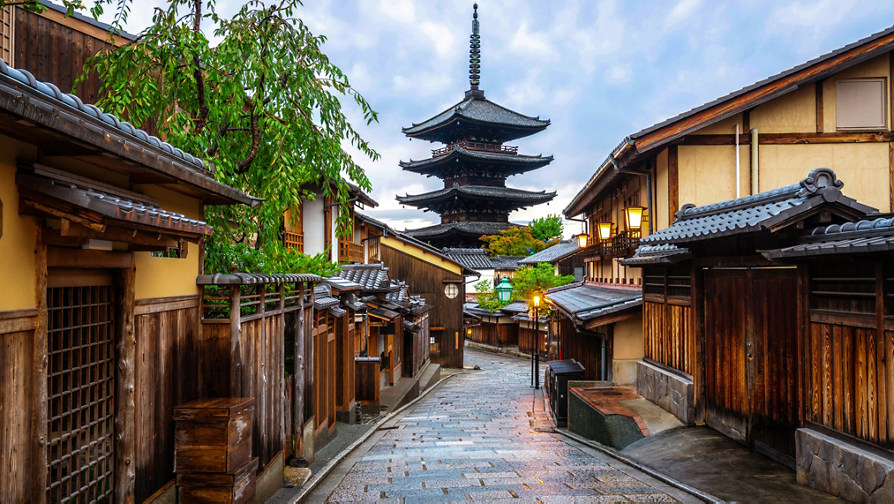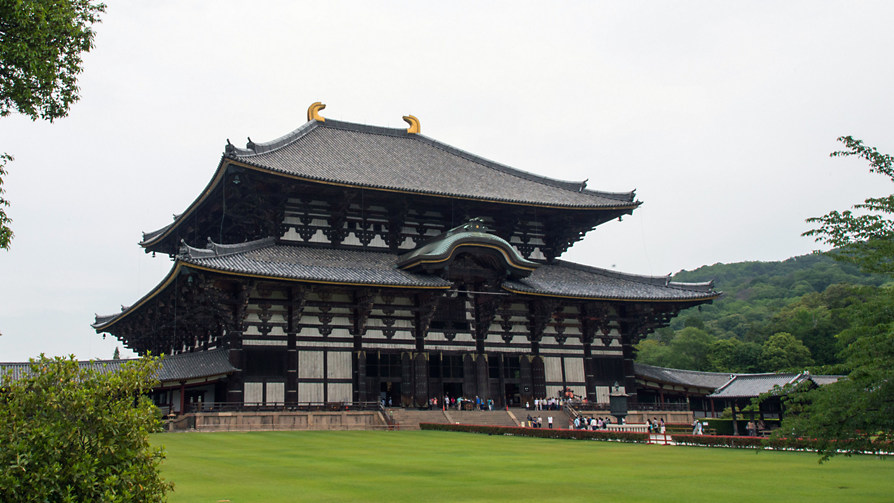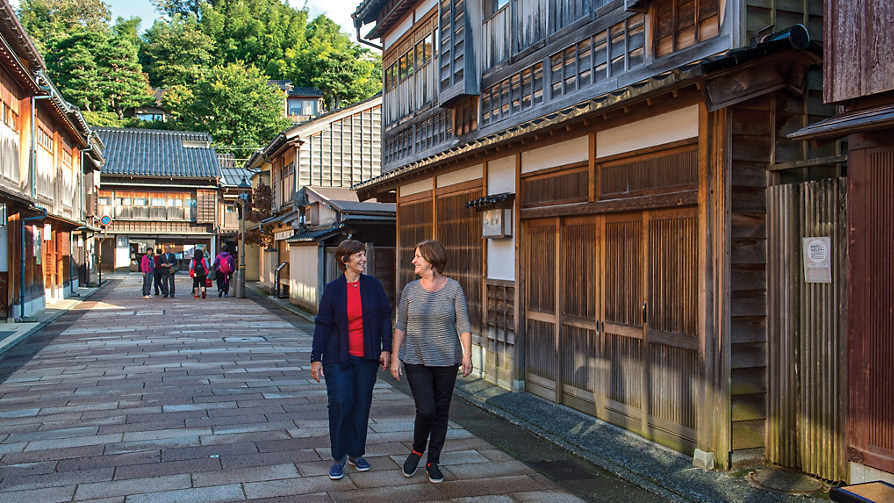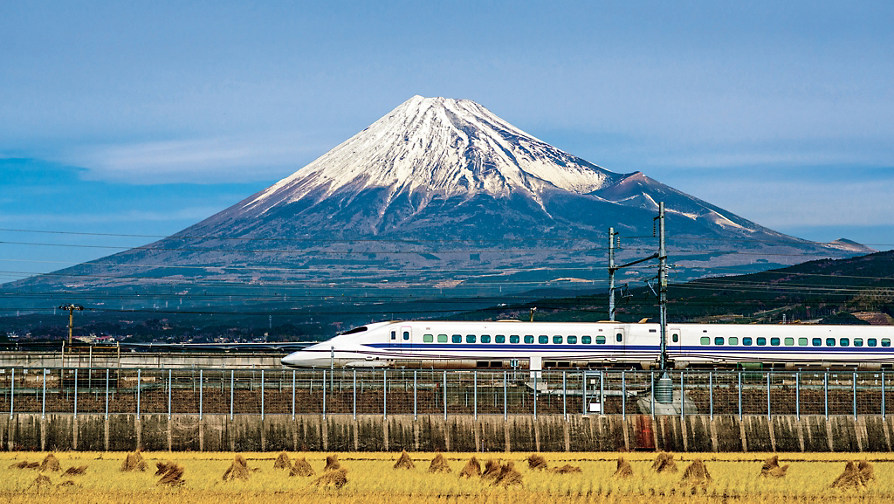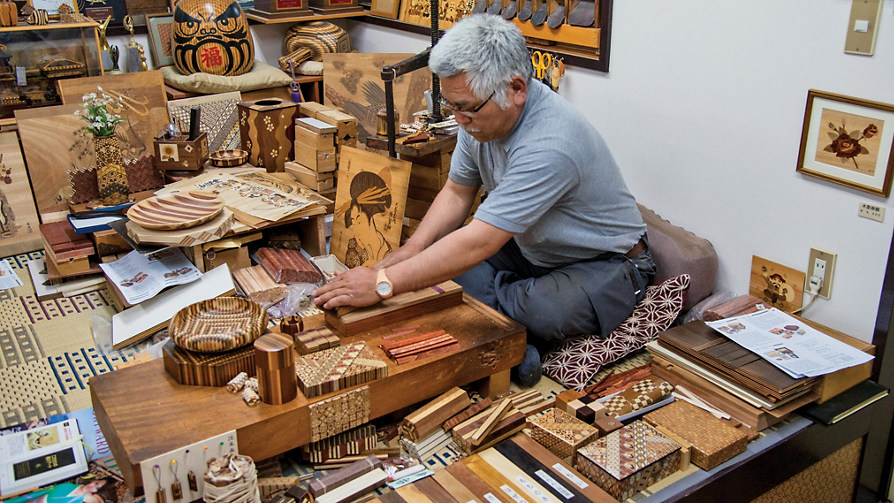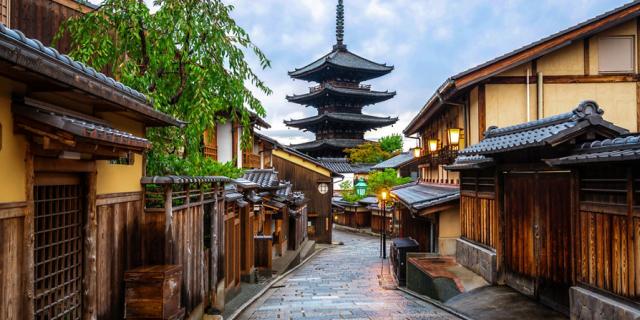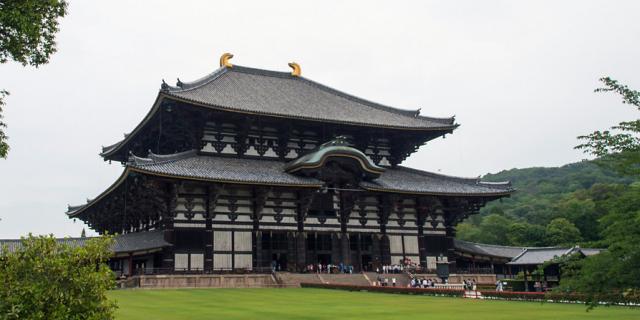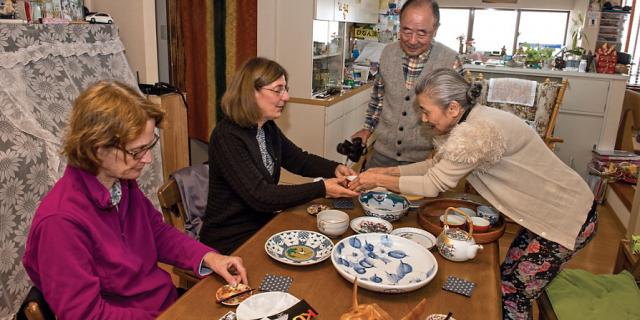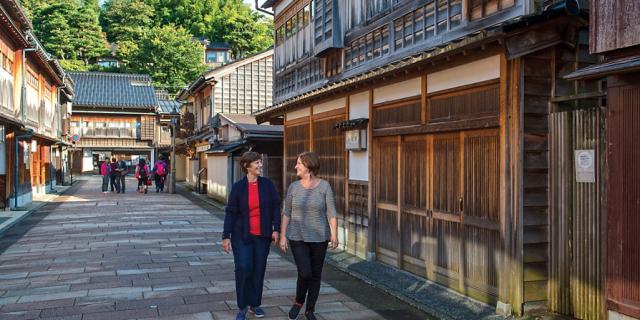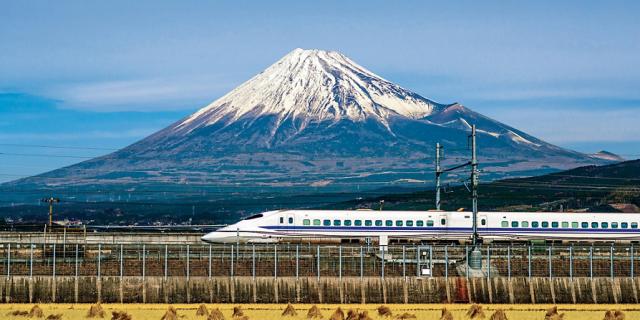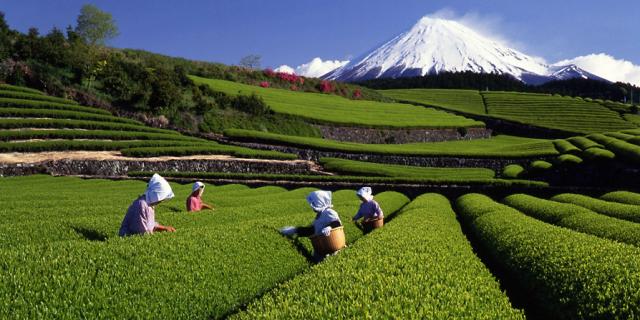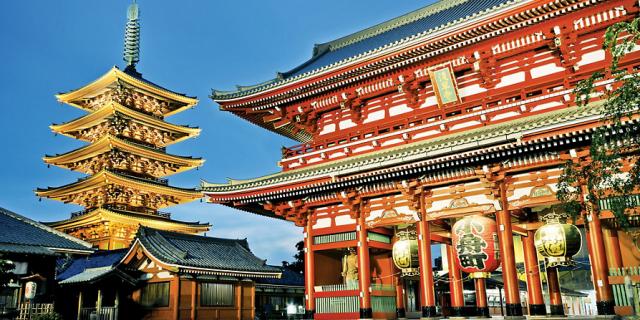- Explore in a small group of 8-16 travelers (average group size of 13)
- All land transportation, including 3 rail transfers on bullet and local trains
- Accommodations for 13 nights
- 27 meals—13 breakfasts, 9 lunches, and 5 dinners
- 13 small group activities
- Services of a local O.A.T. Trip Experience Leader
- Gratuities for local guides and drivers
- 5% Frequent Traveler Credit toward your next adventure
Please note:
Deposit requirement on land trips is $350
Past traveler savings of 5% if you traveled from 2018 onward
New travelers get $100 savings
Travel to Japan with O.A.T. and discover the country you’ve always dreamed of. Discover an Asian land both modern and ancient … where a colorful Shinto festival snakes past neon lights and Tokyo skyscrapers … a modern bullet train speeds past a farmer tending his rice paddies … a well-dressed businessman stops in a Buddhist temple to light incense … and majestic Mount Fuji provides an iconic backdrop for Hakone, where locals and travelers alike relax in volcanic hot springs. Our small group allows us to get an intimate glimpse of Japan's distinct culture, which we'll experience alongside the people that know it best—the locals. We'll find a unique fabric of life when our local Trip Experience Leader introduces us to local artisans that specialize in woodwork, a Buddhist monk who will guide us through Zen meditation, and a local family that will show us their traditions. They'll invite us into their markets, homes, and temples to share a piece of their country with us.
Join us as we explore more than 2,000 years of Japanese history and culture, from ultra-modern Tokyo to the former imperial capital of Kyoto, and all the way back to Kanazawa’s unique samurai architecture. Along the way, we'll also engage in several Controversial Topics—such as whether or not Japan should continue using nuclear power after the Fukushima nuclear disaster of 2011, the discrimination against ethnic Koreans living in Japan, and the struggle for gender equality faced by female sushi chefs. Plus, we'll experience A Day in the Lifeof a rural mountain village.
And whenever you’d like, you have the freedom to explore more of Japan on your own: Break off from the group for independent discoveries—like visiting Origami Hall in Tokyo’s Ochanomizu neighborhood, browsing Hakone’s Museum of Photography, and more—during free time.
DAY 1
Depart U.S.
Afternoon/Evening: Depart the U.S. today on your overnight flight to Tokyo, Japan.
DAY 2
Arrive Tokyo, Japan
Destination: Tokyo
Accommodations: Shizutetsu Hotel Prezio Tokyo Tamachi or similar
Afternoon/Evening: An O.A.T. representative will greet us at the Tokyo airport upon arrival—usually between 2:45pm and 8:30pm—and assist with the approximately 1.5-hour transfer to our hotel in Tokyo, where we'll meet our Trip Experience Leader and fellow travelers, including those who took our optional Tokyo: Ancient & Modern Traditions or New! South Korea: Seoul & Volcanic Jeju Island pre-trip extensions.
Depending on where we stay, our hotel for the next three nights should be located just steps away from a variety of shops, restaurants, as well as the metro. Each of the air-conditioned rooms will likely feature Wireless Internet, a flatscreen TV, and mini-fridge.
Dinner: On your own tonight. This is a great chance to begin getting acquainted with the city, or you may choose to stay in and eat at the hotel and rest after your flight. Feel free to ask your Trip Experience Leader for recommendations.
DAY 3
Explore Tokyo • Meet former sumo wrestler • Explore Shinjuku
Destination: Tokyo
Meals included: B L
Accommodations: Shizutetsu Hotel Prezio Tokyo Tamachi or similar
Breakfast: Served at the hotel starting at 7am, featuring a combination of Japanese and Western options.
Morning: We’ll meet with our Trip Experience Leader for a Welcome Briefing at around 9:30am in the hotel. During this briefing, we will introduce ourselves and review our itinerary in more detail (including any changes that may need to occur). Our Trip Experience Leader will also discuss logistics, safety and emergency procedures, and answer any questions we may have.
After the briefing, we’ll board our bus around 10:45am and drive 45 minutes to a restaurant owned by a former sumo wrestler. Upon arrival, we'll witness a demonstration of this iconic sport by two former wrestlers, beginning with a ritual of purification and eventually engaging in combat. Sumo has been the most popular form of sports entertainment in Japan for the last 1,000 years, making it integral to local culture. During an interactive demonstration, which we'll have the opportunity to participate in if we would like, we'll learn about the history of sumo, the rules, as well as its connection to the Shinto religion. Throughout our conversation, we'll have the opportunity to ask questions of these impressive athletes and learn about their own perspectives on the sport.
Lunch: Around 11:45am, we'll hear an explanation on the traditional lunch being prepared for us today: Chanko, a hot pot dish traditionally consumed by sumo wrestlers to maintain their competitive physique. This hearty soup typically features a chicken broth base, large quantities of protein, and vegetables such as daikon and bok choy. To increase the calorie intake, wrestlers typically pair this meal with large quantities of rice. This is a unique opportunity to eat the food of choice for sumo wrestlers right alongside them.
Afternoon: After lunch, we'll sit down with the restaurant's owner to discuss his past experience as a wrestler and to discover sumo traditions—an exclusive O.A.T. feature. We'll even watch a slide show which will illuminate the intense training process, as well as hear about the wrestler's personal reasons for participating in the sport and eventually making the decision to retire.
Around 1:30pm, we'll bid farewell to our hosts and make the 45-minute bus ride back to the hotel. From approximately 2:15pm to 6pm, enjoy free time to explore as you wish. Perhaps you'd like to get a taste of different sections of the city, in which case you may want to join the 14 million Tokyo residents who use the subway and learn to get around like a local. Ask your Trip Experience Leader how you can obtain a pre-paid pass called "Suika." Alternatively, you may wish to visit the Meiji Shrine, a Shinto holy place. The shrine was erected in honor of Emperor Meiji, who came into power in the 19th century when the shogunate powers fell. It was under his leadership that Japan adopted modern customs and became a serious world power. For a more relaxed afternoon, perhaps you'd like to learn a few Japanese phrases from your Trip Experience Leader and try them out as you wander in and out of shops. This is a great opportunity to foster casual, impromptu interactions with locals, as well as to bolster your confidence with the new, handy phrases you've learned.
Around 6pm, we'll gather for a 45-minute orientation walk around the vicinity of the hotel. Our Trip Experience Leader will show us where we can find anything we may need, such as an ATM or pharmacy. We will also familiarize ourselves with nearby landmarks and learn about local transportation. Later, we'll also stop by a traditional izakaya, an informal Japanese pub. There, we'll have the opportunity to sample sake, a Japanese rice wine, as well as yakitori, skewered and grilled chicken.
Dinner: On your own this evening. During the orientation walk, this is a wonderful time to get recommendations and directions from your Trip Experience Leader.
Evening: Around 7pm, we'll join our Trip Experience Leader for a walk around Shinjuku, a famous entertainment and red-light district in Tokyo. We'll first stop an an izakaya, a casual Japanese bar that also serves snacks. After finishing our drink, we'll continue our explorations of Shinjuku, and see how other hostesses and sometimes young hosts attract customers to their clubs and bars. Our Trip Experience Leader will engage the locals we pass in conversation, asking what they think about these hostess bars and perhaps share their own experiences.
We'll return to our hotel around 8pm; the rest of the evening is free.
DAY 4
Tokyo • Taiko drumming experience • Explore Asakusa • Controversial Topic: Female sushi chefs & gender discrimination with sushi chef Yuki Chizui
Destination: Tokyo
Meals included: B L D
Accommodations: Shizutetsu Hotel Prezio Tokyo Tamachi or similar
Exclusive O.A.T. Activity: Today will feature the Controversial Topic of female sushi chefs in Japan. Historically a male-dominated field, women who have tried to enter this traditional world are met with a barrage of challenges beyond the already difficult process of studying to become a sushi chef. We’ll meet with female sushi chef Yuki Chizui who will share her story of how she managed to succeed despite these gender prejudices—and offer us a taste of her creations. Read more about this activity below.
Activity Note: Because of limited space, we recommend you pack an overnight bag on Day 4 for the next two nights in Hakone. On Day 5, the rest of your luggage will be transferred to the following hotel in Kanazawa. Ask your Trip Experience Leader for details.
Breakfast: Served at the hotel beginning at 7am, featuring a combination of Japanese and Western options.
Morning: At about 9am, we’ll transfer 30-45 minutes via taxi to a taiko studio. Taiko are traditional drums that have been used throughout Japan's history—from setting the beat for marching armies to adding a tempo to boisterous festivals. Upon arrival, we'll remove our shoes and descend into the soundproof studio, where we'll be greeted by the taiko drum master. We'll learn from the master about the significance of this musical instrument in local culture, and later observe a short performance. We'll even get to try our hand at drumming with a short intensive introduction to the art form followed by time to perform patterns and rhythms on our own, as well as within the group. After our immersive musical experience, we'll then hear from the drum master about their personal relationship with drumming, as well as the concerns about keeping this longstanding tradition alive. This intimate dialogue gives us a chance to further understand the value of this practice, as well as to ask questions about it.
Then around 11am, we'll walk to the well-known district of Asakusa around. As we explore this part of the city, we'll see where old meets new. While the appearance of Asakusa retains its historical charm, we'll find modern innovations in the district's shopping area. We'll stroll down the streets that host more than 100 shops, which sell everything from kitchen appliances to hand-cut glass. We'll also pass by prominent temples, providing architectural and cultural insight to this ancient country. With the guidance of our Trip Experience Leader, we'll familiarize ourselves with this bustling district, and glean ideas on how to spend our free time for a little over an hour.
For a local specialty, head to a little shop called Suzukien to indulge in its famous, matcha-flavored ice cream. Matcha is a type of green tea, popular in Japan both for drinking as well as an ingredient for a number of recipes. This is a great opportunity to enjoy a traditional delicacy alongside locals as they line up to be served. To enjoy matcha in another form, ask your Trip Experience Leader about arranging a traditional tea ceremony at Kakinuma. The Japanese tea experience is a delicate balance of presentation, preparation, and performance. This is an approximately 1- to 1.5-hour activity and will require advanced notice, should you be interested. Of course, another way to continue enjoying this multi-faceted neighborhood is to explore the streets by foot, such as Festival Street and Sushi Street, allowing you to take in the frenetic pace of activity and observe and interact as you go along. Your Trip Experience Leader can always point you in the direction of particular areas of interest, should you want some ideas.
Then around 12:15pm, we’ll take a 30-minute subway ride to our next destination—lunch.
Lunch: Around 1pm at a local women-owned and operated sushi restaurant, where the manager and staff will introduce us to their menu.
Afternoon: Today, our lunch will coincide with learning about a Controversial Topic in Japan: Gender discrimination in the world of sushi chefs. As female sushi chef Yuki Chizui will tell us, breaking into this field—a so-called “sacred profession” traditionally held by men—was anything but easy.
Japan is at once the most modern and the most ancient of countries. Its cities feel high tech and Western, yet it is also fiercely protective of its culture and traditions. But time does not stop for any country, and in recent years Japan has attempted to embrace some inevitable changes. One of the most notable changes is the culture’s view on Japanese women in society. Back in the 17th century, a woman’s role was restricted to a domestic one, nothing more. But after World War II, women’s rights saw some advancement, receiving the right to vote in 1946. And now, in the 21st century, more and more Japanese women are being encouraged by the government to enter the work force. Despite this, gender in Japanese society is still far from equal—only 10% of management positions are held by women, and a Japanese woman’s earnings is 67.8% of a man’s. In such a male-dominated society, the road to equality is clearly still blocked by many challenges. One profession in particular has a very strong “No Girls Allowed” policy in place—the vocation of a sushi chef.
As with any specialty Japanese occupation, training to become a sushi chef is no easy feat even for a man. It takes years of grueling study. After that, the hopeful chef must find employment in a reputable restaurant, where he will most likely do little more than watch—and wash dishes—at first. Now imagine going through all of that as a Japanese woman. The odds are already stacked against any female sushi chef, regardless of her training. There is a litany of strongly-held—yet completely unfounded—beliefs as to why women cannot be sushi chefs. The most common excuses include women’s hands being too small and too warm to prepare sushi correctly. Others claim that feminine products like makeup and perfume would interfere with taste and smell. These old wives’ tales may sound ridiculous to a Western ear, but they have proved to be major hurdles for female sushi chefs here.
This has not stopped a few intrepid chefs from forging a path through this unforgiving, male-dominated profession. Sushi chef Yuki Chizui will tell us how she carved out room for herself in this restrictive world. Her interest in sushi began in college when she worked part-time at a sushi restaurant. She first noticed how chefs directly interact with their customers over the counter and felt that was her calling. She began to study the art of sushi making, but it was not an easy road. In 2012, when she first served her sushi to two male customers—a manager and his subordinate—she was humiliated when the manager asked his subordinate to taste it first since it was made by Yuki, a woman. Undeterred, she has amassed 10 years of experience and is now the head chef and general manager of this restaurant. She wants to help turn the role of a sushi chef into a lifelong career choice for women, free from discrimination and prejudice. She also collaborates with young female artists to create new sushi tools made specifically for women and special kimono uniforms to wear at her restaurant.
There is further hope for the future of women sushi chefs in the creation of newer, more inclusive schools, such as Tokyo Sushi Academy. More than 20 percent of the enrolled chefs-in-training are women. That is more than double the amount of female students since the school opened in 2002. Still, as the approximately 35,000 sushi restaurants in Japan are almost all run by male chefs, it is clear women sushi chefs still have a long way to go. During our hour-long conversation, we’ll have around 40 minutes to ask Yuki any questions we may have about this fascinating topic.
Then around 2:30pm, you'll have the option to continue exploring with your Trip Experience Leader, or return to the hotel by taxi which will take between 45 minutes and 1 hour, putting you back at the hotel around 3pm. You can find a taxi at Kokusai Dori or on a number of other main streets in the area. Check with your Trip Experience Leader for more information. Until around 5:45pm, enjoy some additional free time to either relax and freshen up at the hotel before dinner, or continue your discoveries. Check with your Trip Experience Leader for ideas on how to spend your time, whether you'd care to visit one of the many historical shrines and temples in the area or perhaps visit a nearby rice cracker shop and talk with the owner about their business.
Around 5:45pm, we'll depart the hotel for a 15-minute walk to a nearby restaurant for dinner.
Dinner: Around 6pm our group will gather for a Welcome Dinner at a local restaurant, featuring traditional Japanese food such as sashimi (fresh, raw fish), local vegetables, tempura (various foods fried in batter), and more.
Evening: Truly immerse yourself in the local culture with this night in Tokyo. Perhaps you'll venture to Akihabara, a bustling shopping district famous for its electronic retailers. Here, you can also find a taste of true Japanese culture at a number of the manga (Japanese comics and graphic novels) and anime (hand-drawn and computer-animated Japanese media) stores.
This evening, we also recommend you take some time to pack an overnight bag to bring with you to Hakone for the next two nights. Tomorrow morning, the rest of your luggage will be transferred to Kanazawa for our arrival on Day 7.
DAY 5
Travel overland to Hakone • A Day in the Life of Minamiashigara Village
Destination: Hakone
Meals included: B L D
Accommodations: Hotel Recove Hakone or similar
Exclusive O.A.T. Activity: Today we will visit a small mountain town and experience A Day in the Life of Minamiashigara Village. This is a unique opportunity to witness one of Japan’s elder villages, where the population is primarily made up of senior citizens. We will learn how the residents thrive here and take part in their day-to-day routines. We’ll also enjoy a karate demonstration and visit a local children’s nursery, where we’ll see how rural Japan’s youngest residents learn and play. Read more about this immersive activity below.
Activity Note: Total travel time to Hakone is approximately two hours, but we will make a three-hour stop along the way. Please also note: The karate studio and nursery from our A Day in the Life experience are closed during the weekends. If this day should fall on a weekend during your departure, you will instead visit a local senior housing facility and take part in some of their daily activities, such as learning origami.
Breakfast: Served at the hotel beginning at 7am, featuring a combination of Japanese and Western options.
Morning: We’ll board our motorcoach at around 8:30am and depart for the mountain region of Hakone, located about 55 miles southwest of Tokyo.
Around 10am, we’ll arrive at Minamiashigara Village—52 miles outside of Tokyo and situated at an elevation of 826 feet. It is here that we’ll enjoy our A Day in the Life experience with the local villagers. Japan is an aging society, and we will be especially aware of this in Minamiashigara, as the average age of residents is 65 with a population of around 580 people. One major factor that led to the shrinking of villages like Minamiashigara is urban migration. Young people, or those simply in search of work, left their homes for the big cities, such as Tokyo, in search of a better life, and they continue to do so today.
We’ll begin today’s immersive experience with a visit to a local market run by the village, getting a sense of the various types of vegetables, meat, and traditional snacks sold there. Then we’ll continue our journey to town—about a 20-minute drive. Upon arrival, we will be met by community leader Mr. Yuji Ueda who has been the chairman of the local village community for the last 12 years. Mr. Ueda moved here from Tokyo for work at the age of 28, and soon came to love the village’s natural beauty. He will lead us on an introductory walk through the village around 10:30am, during which we’ll see where locals do their shopping and go about daily life. He will also point out the scenery he fell in love with as a young man, from the river to the green mountains. During our walk, we’ll also stop to visit one of the community farms—a green tea farm, citrus farm, or wasabi (green horseradish) farm, depending on the season. We may even have a chance assist in harvesting if the time of year is right.
Lunch: Around 12pm at the home of a local family. We'll sit down together to savor traditional rural Japanese dishes. Over the course of our meal, we'll have the opportunity to speak even deeper about social issues, such as learning how the locals feel about the evolution of their village and the effects of urban migration. We may also want to ask how life has changed in Minamiashigara over the last 50 years.
Afternoon: After lunch, our hosts will have one last tradition to share with us: A simple yubitaiso, or hand exercise, that residents of the village practice every day to promote rejuvenation and brain health. You may wish to incorporate this special exercise into your own daily routine.
We’ll bid the villagers goodbye and drive about 30 minutes to a local karate studio, arriving around 1:40pm. We will be met here by the master of the studio, or dōjō, who will teach us the spirit of karate and share his personal story of earning a black belt at a world championship tournament. Then we will be treated to a demonstration of this ancient martial art.
Around 2:20pm, we’ll head to our final stop on our A Day in the Life experience—a local children’s nursery—an approximately 10-minute walk past the scenic rice fields. The nursery will give us a glimpse of how the youngest members of this rural society learn and play. The children here range in age from 3-5 years old and we will be able to take part in their daily discoveries, as they learn to behave in a group, take care of one another, practice taiko (Japanese drum), and other seasonal activities. We’ll then be asked to share with the class what American children are taught in their nursery schools.
Then around 3pm, we'll depart Minamiashigara Village to continue our 90-minute drive to Hakone, arriving and checking in to our hotel by approximately 4pm. Depending on where we stay, our hotel for the next two nights should be located at the foothills of Mount Fuji, and feature authentic hot spring baths. Room amenities may include Wireless Internet, flatscreen TV, and mini-fridge.
From about 4pm-6pm, enjoy some free time to relax before dinner. Perhaps you'd like to enjoy the on-site onsen, a traditional Japanese bathing facility featuring hot spring water.
Dinner: Around 6:30pm at the hotel, featuring traditional dishes.
Evening: The evening is free for your own discoveries. Relax at the hotel bar and restaurant for a nightcap, or perhaps take in the scenic surroundings of the countryside with an evening walk.
DAY 6
Hakone • Wood workshop visit • Meet with local fisherman at Lake Ashi
Destination: Hakone
Meals included: B L D
Accommodations: Hotel Recove Hakone or similar
Activity Note: Alternative activities may be substituted for some of today’s visits depending on weather conditions.
Breakfast: Served at the hotel from 7:30am-9am, featuring a combination of Japanese and Western options.
Morning: This morning, we’ll board our bus around 9am and drive approximately 20 minutes to meet a fisherman who will tell us about about his fishing business and Lake Ashi, a scenic crater lake situated along a wall of the Mount Hakone caldera. This caldera is a complex volcano which last erupted approximately 1,000 years ago. The lake and surrounding area draw many visitors each year for a number of recreational activities, such as hiking, boating, camping, and of course, fishing. Our generous host will take us on a boat ride (weather permitting), and tell us about important landmarks in the area, such as the sacred Kuzuryu Shrine. This interaction is a wonderful opportunity to get to know a local and glean firsthand insight into the ways of life here, such as how to make a livelihood.
At around 10:45am, we’ll leave the fisherman and board the bus for a short ride to Hamamatsuya, a workshop specializing in wooden handicrafts. There, we'll meet with the owner of the shop, who is the fourth generation in his family to carry on this well-established business. We'll see the creation of the elaborate woodwork of Hakone Yosegi Zaiku, a special product of Hakone featuring complex inlaid designs using varying shades of wood. After the demonstration, we'll have the opportunity to ask the owner any questions we may have about this exquisite artistry. Afterwards, you'll set out again for Hakone Yumoto for lunch.
Lunch: Around noon at a local restaurant in Hakone Yumoto.
Afternoon: After lunch, you'll meet a geisha, who will perform a traditional Japanese dance and play exclusively for you and your fellow travelers.
Then, around 3pm, we'll depart for the 30-minute drive to our hotel, where we'll enjoy free time for the remainder of the afternoon. Check with your Trip Experience Leader for ideas. Of course, you're in the land of hot springs, so should you be interested in a soak, Hakone is a wonderful place to indulge in this relaxing pastime.
Dinner: We’ll regroup for dinner at the hotel restaurant around 6:30pm, featuring a combination of Japanese and Western options. Your Trip Experience Leader will introduce the traditional options, as well as demonstrate how to eat them like locals.
Evening: After dinner, your Trip Experience Leader will provide introductions to Japanese culture through practices such as origami (the art of paper folding), kendama (a traditional toy game), and shuji (Japanese calligraphy). If time permits we may even have the chance to learn a local dance from the hotel's staff.
DAY 7
Hakone • Bullet train • Express train to Kanazawa
Destination: Kanazawa
Meals included: B D
Accommodations: Kanazawa New Grand Hotel or similar
Activity Note: Find the rest of your luggage waiting at our hotel in Kanazawa this afternoon.
Breakfast: Served at the hotel beginning at 7:30am, featuring a combination of Japanese and Western options.
Morning: We’ll leave our hotel at about 8:45am, driving 45 minutes to the train station, where shortly after 10am we board a bullet train—the legendary high-speed train service that revolutionized travel in Japan.
The Japanese call this train the shinkansen. It is one of the world's finest quick-transit trains, and still among the fastest trains in the world, traveling at speeds of up to 200 mph. Prior to boarding, you will need to stand at a precise location indicated by your coach and seat accommodations. The train stops exactly where indicated and sure enough, your coach will be right in front of you. We'll board the bullet train in Odawara for the first leg of our journey (approximately 1 hour), and then finish our trip to Kanazawa on the Limited Express train (approximately 3.5 hours in total, including our transfer between trains). Along the way, we'll enjoy views of Japan's rolling countryside and modern cityscapes.
Lunch: On your own today at your convenience. We suggest doing as the Japanese do: Buy a packed lunch (called eki-ben) in the station and enjoy it on the train. Eki-ben lunches are one of the attractions of train travel in Japan and usually include rice or noodles, vegetables, and sushi or meat.
Afternoon: We arrive at Kanazawa station around 2:48pm and transfer to our hotel. Depending on where we stay, our hotel will likely be located in the heart of Kanazawa. Hotel amenities may include a restaurant and coffee shop. Room amenities will likely be a mini fridge, tea- and coffee-making facilities, cable TV, Wireless Internet, and private bath with hair dryer.
After checking in, we'll take an orientation walk around 4pm. This is a great opportunity to ask your Trip Experience Leader to point out restaurant recommendations and get acquainted with the area surrounding our hotel. Then, the rest of your afternoon is free for your own discoveries.
Dinner: Around 6pm at a local restaurant, featuring authentic Japanese cuisine.
Evening: We’ll return to our hotel around 8pm, and you’re free to explore the surrounding area on your own, or relax at the hotel bar, share pictures from your discoveries throughout the day, or simply head back to your room to retire for the night.
DAY 8
Explore Kanazawa • Visit Kenrokuen Garden • Controversial Topic: Nuclear energy with Fukushima survivor Mr. Morishima • Visit gold leaf factory • Omicho Market visit
Destination: Kanazawa
Meals included: B L
Accommodations: Kanazawa New Grand Hotel or similar
Exclusive O.A.T. Activity: Today's activities feature a conversation surrounding the Controversial Topic of nuclear energy with Fukushima survivor, Mr. Morishima. We'll hear his firsthand account of the 2011 disaster, a tragic event which left tens of thousands dead and forced hundreds of thousands to flee their homes. This challenging conversation will offer personal insight into the topic, as well as perspective on traditional methods of energy production.
Breakfast: Served at the hotel beginning at 7am, featuring a combination of Japanese and Western options.
Morning: We begin our exploration of Kanazawa around 8:30am when we depart by bus for a panoramic tour of this historic city.
Between the 16th and 18th centuries, Kanazawa was a prosperous castle town in the domain of Kaga, ruled by the Maeda Family, and it has been one of the cultural centers of Japan ever since. Located on the coast of the Japan Sea, Kanazawa was spared much of the destruction that World War II brought to the country. It is famous today for its unique architecture, exquisite Kaga-style handcrafts—including silk-dyeing and lacquerware—delicate regional cuisine, and the Kenrokuen Garden, one of the most treasured in Japan. We start our tour with a 1-hour morning visit to this very garden, opened to the public in 1875 and one of the most visited garden spots in all of Japan. Here, we'll have the opportunity to admire garden landmarks such as the mid-18th century Kaisekito Pagoda, the two-legged stone lantern of Kotoki Toro, and the placid waters of Kasumi Pond.
At about 10am, we'll depart Kenrokuen for a 5-minute drive to Los Angeles Café, where we’ll meet with the owner to discuss the Controversial Topic of nuclear power in Japan. As a survivor of the 2011 Fukushima disaster, 54-year-old Mr. Morishima is painfully familiar with the topic. Today, we’ll hear his harrowing story, as well as come to understand the ongoing controversy surrounding nuclear energy. Depending on the day, we may also be joined by Mr. Morishima’s 18-year-old son, Hiromi, who brings his own unique perspective to the conversation.
Prior to the Fukushima incident, Mr. Morishima lived with his wife and two children in Fukushima prefecture, where he also ran a doll-making business. On March 11, 2011, life changed in an instant when a 9.0 magnitude earthquake shook the country, causing tsunami waves to damage backup generators at the Fukushima Daiichi plant. The loss of power prompted cooling systems to fail and fuel rods to eventually melt, resulting in a series of explosions and considerable nuclear material leakage. Amidst the chaos and destruction, Mr. Morishima and his family—along with nearly 160,000 others living in the vicinity—were forced to flee the growing threat of radiation exposure, some of them driving more than 48 hours to reach safety. More than 20,000 people were killed that day between the earthquake, tsunami, and nuclear disaster. And those who remain are left to wonder—or fear—what the future holds for Japan’s energy sector.
Today, Mr. Morishima is a survivor, and once again, a business owner, but his life is not without trauma or hardship, particularly as the debate about nuclear power dependency rages on. Nearly a decade after the disaster, just 36% of the nation condones nuclear energy generation, while 64% are opposed to it. While it’s true that all nuclear reactors were shut down over safety concerns following Fukushima, a number of them have restarted since that time. Today, nine nuclear power plants are in operation, a significant decrease from the 54 nuclear plants utilized before Fukushima, but certainly no consolation to those suffering from radiation exposure or forced to evacuate their homes.
In October 2020, the national conversation surrounding nuclear power intensified when the government proposed dumping storage tank water from the plants into the ocean. These tanks contain millions of tons of water used to cool reactors—water that is contaminated with radioactive tritium, a cancer-causing hazard when consumed, absorbed through the skin, or inhaled as a gas. Fishermen, environmental activists, and the general public have come out strongly against this initiative, but many view it as an alarming indication that government officials haven’t learned anything from the events of 2011.
During our conversation, we’ll hear from Mr. Morishima for about 20 minutes before opening up the dialogue to a 40-minute Q&A. Take this time to ask any questions you might have. Perhaps you’d like to know how Mr. Morishima copes with his trauma or if he believes the government will ever do away with nuclear power in his lifetime.
Around 11:15am, we'll depart for a short ride to our lunch spot for the day.
Lunch: At a local restaurant, around 11:30am.
Afternoon: After lunch, we'll walk around the Higashi Chaya District, a traditional neighborhood known for its teahouses. Then, around 1pm, we'll depart for a 15-minute drive to experience one of Kanazawa’s most famous art traditions—gold leaf. We will arrive at the headquarters of Hakuichi, a local company famous for its gold leaf production—and meet one of the masters who will give us an introduction to this intricate craft. We’ll then get a hands-on lesson and learn how to apply the shimmering foils ourselves, creating postcards to take with us. Afterwards, we’ll visit Hakuichi’s showroom to view the gold-leaf artworks on display, including an impressive golden Samurai costume.
Later, at about 2:30pm, we'll drive 20 minutes to visit Omicho Market. This spacious, indoor market is comprised of stalls selling fresh produce, seafood, meat, and various specialty dishes. We’ll peruse the offerings, sample local cuisine, and have the opportunity to mix and mingle with local shoppers.
We'll then depart around 3:45pm for the 15-minute drive to our hotel, and you have the rest of the afternoon to make your own discoveries. One site you may want to visit for the remainder of the afternoon is 16th-century Kanazawa Castle, the former headquarters of Kaga Domain, a feudal estate in Edo period Japan. The castle is built on the highest ground between the Sai and Asano Rivers, giving it a strategic advantage in times of defense. The main features of the structure are the Hishi Yagura (watch tower), Tsuru-no-maru Dobei (double earthen stone wall), Gijikken Nagaya (multi-sided, two-story turret), and Hashizume-ichi-no-mon (entrance gate).
Dinner: On your own tonight—feel free to ask your Trip Experience Leader for recommendations.
Evening: You’re free to make your own discoveries. Perhaps you’ll observe the local nightlife on an evening stroll, take advantage of the hotel amenities, seek out live music, or retire early to rest up for tomorrow.
DAY 9
Kanazawa • Optional Gokayama tour
Destination: Kanazawa
Meals included: B
Accommodations: Kanazawa New Grand Hotel or similar
Breakfast: Served at the hotel beginning at 7am, featuring a combination of Japanese and Western options.
Morning: Today you have the freedom to spend a day in Kanazawa as you wish, making your own discoveries in this historic city. Or you can join us for an optional full-day excursion to Gokayama, a mountain village—and a UNESCO World Heritage Site—in the forested countryside outside of Kanazawa. We’ll depart at around 8:30am for the hour-long drive.
Because of its relative isolation, this area developed independently of Japanese society, resulting in a unique culture and lifestyle. In addition to creating their own dances, festivals, and traditions, residents developed a distinctive architectural style known as gassho-zukuri. Characterized by steeply pitched thatched roofs that are both striking and functional, these dwellings are considered to be some of the most efficient farmhouses in Japan—and we'll discover why as we explore the 20 or so houses of the Ainokura district this morning.
Then around 11am we'll visit a workshop and local community center to see how washi—a thick, fibrous paper made from mulberry bark—is created. This traditional paper is known to last 1,000 years. After learning how it's done, we'll try our hand at creating washi paper postcards, personal creations we'll be able to take home with us. Later, we'll also learn the art of mochitsuki, the traditional ceremony of rice-cake making, using a wooden hammer to achieve the correct texture. Mochi is made of mochigome, a short-grain glutinous rice and can be served in a variety of flavors. Afterward, we'll enjoy our hard work and indulge in this national delicacy.
Around 12:45pm, we'll depart the community center for a short ride to our lunch spot for the day.
Lunch: For those who do not take the Optional Tour, lunch is on your own today. Be sure to check with your Trip Experience Leader beforehand for suggestions. For those who do join the Optional Tour, we'll enjoy a traditional lunch of soba (buckwheat noodles) at a local restaurant around 1pm.
Afternoon: Around 2pm, we'll continue on to Murakami House, which was built in 1578 and is the oldest ghasso-style house in the area. During our visit here, we'll learn more about the history and culture of Gokayama, and enjoy a traditional dance performance called Kokiriko, given by a local family. Our group will be welcomed and encouraged to participate.
We'll depart for our hotel at around 2:45pm, arriving in Kanazawa about 1.5 hours later. The remainder of the day is free for your own discoveries.
Dinner: On your own tonight. Perhaps you’d like to browse the surrounding area to seek out a local specialty.
Evening: You’re free to make your own discoveries, exploring on your own, or relaxing at the hotel bar and restaurant for a nightcap.
Gokayama - $150/person
On this Optional Tour, we'll discover the unique culture, lifestyle, and architecture of Gokayama, a mountain village—and UNESCO World Heritage Site—in the forested countryside outside of Kanazawa. First, we'll witness the distinctive architectural style known as gassho-zukuri, which is characterized by steeply pitched thatched roofs that are both striking and elegant, as we tour the traditional houses of Ainokura. Then, we visit a workshop in Gokayama to see how washi—a thick, fibrous paper made from mulberry bark—is created. Afterward, we'll learn the art of mochitsuki, or rice-cake making, before we head to Murakami House, which was built in 1578 and is the oldest gassho-style house in the area. During our visit here, we'll learn more about the history and culture of Gokayama, enjoy a traditional dance performance, and savor a traditional lunch of soba (buckwheat noodles) at a local restaurant.
DAY 10
Kanazawa • Home-Hosted Visit: Tea with a local family • Train to Kyoto
Destination: Kyoto
Meals included: B L D
Accommodations: Hotel Elcient Kyoto or similar
Exclusive O.A.T. Activity: Today we will take part in a Home-Hosted Visit with a local family. In a smaller group, you’ll enjoy tea and a traditional sweet while learning about our hosts and their daily lives.
Breakfast: Served at the hotel beginning at 7am, featuring a combination of Japanese and Western options.
Morning: At about 9am, we'll split into smaller groups of no more than 4 travelers and depart for a Home-Hosted Visit with local families who live in various sections of the city, about a 20-minute drive. This is a rare opportunity to witness the everyday lives of typical residents of Kanazawa and glimpse authentic Japanese culture. Some of our hosts are accomplished flower arrangement masters, are skilled in Japanese calligraphy, cultivate bonsai trees, or fold origami, and will be happy to share these talents with you.
During our enlightening cultural exchange, we'll have the opportunity to browse family photos, learn about our hosts, and converse about various Japanese traditions over a cup of tea, a tradition that is central to Japanese culture. Your hosts may or may not speak some English, but you will find that some forms of communication are universal. Get creative with hand gestures, or perhaps employ some of the new phrases you learned during your time in Japan.
Around 11:30am, we'll bid farewell to our kind hosts and make the short drive back to our hotel, where our group will gather and shortly thereafter depart for the 15-minute drive to Kanazawa train station.
Lunch: Around noon at a local restaurant in the station.
Afternoon: At 2:20pm, we’ll take a 2-hour train ride to Kyoto. Kyoto was Japan's imperial capital from the eighth to 19th centuries. It remains an important cultural center—and has been designated a UNESCO World Heritage Site—and we'll have five full days to explore its many wonders. When we arrive, we’ll transfer to our hotel, where we’ll receive our room assignments and check in around 4:30pm. Depending on where we stay, our hotel should be located near major subway lines, and within walking distance of many shops and restaurants, ideally located for exploring the city. Rooms will likely include a TV, refrigerator, tea-making facilities, and private bath with hair dryer. Hotel amenities should include Western-style and Japanese restaurants, free Internet access, and laundry service.
Around 5:30pm, you may join our Trip Experience Leader for an orientation walk around the hotel’s vicinity. During our explorations, we'll walk to a local restaurant.
Dinner: Around 6:30pm tonight, in a local restaurant.
Evening: From around 8pm, you’re free to make your own discoveries, exploring the surrounding area on your own, or relaxing at the hotel bar and restaurant for a nightcap.
DAY 11
Kyoto • Arashiyama Bamboo Grove • Kinkakuji • Controversial Topic: Discrimination of ethnic Koreans in Japan with a member of Kyoto's Korean community
Destination: Kyoto
Meals included: B L
Accommodations: Hotel Elcient Kyoto or similar
Exclusive O.A.T. Activity: Today, we'll meet with a member of Kyoto's Korean community to learn about the Controversial Topic of discrimination against ethnic Koreans in Japan. Read below to learn more about this sensitive topic.
Activity Note: Kinkakuji Temple is very crowded with tourists. Plus, Arashiyama Bamboo Grove is very crowded with tourists, as it is one of the most popular spots in Kyoto. Also, accommodations in Kyoto are quite small and often not wide enough to fully open a suitcase.
Breakfast: Served at the hotel beginning at 7am, featuring a combination of Japanese and Western options.
Morning: Around 8:30am we’ll board the tram like a local and head to Arashiyama. We'll arrive around 9am and depart on foot for the approximately 1-hour walk through Arashiyama Bamboo Grove, where we'll see massive bamboo stalks. This is one of the most photographed sites in the city, and visitors come from all over the world to be dwarfed by these towering plants. Our morning visit will give us an opportunity to enjoy the grove during a quieter time of day with fewer crowds.
At around 10:15am, we'll depart for the short drive to visit Kinkakuji Temple, a UNESCO World Heritage Site. The striking architecture of Kinkakuji, also known as the Temple of the Golden Pavilion, dates from 1397, when it was built by the third shogun (military commander) of the Ashikaga Shogunate. The reflection of the pavilion on the water of the adjacent pond produces an iconic view.
Lunch: At about 12:45pm in a local restaurant.
Afternoon: At about 1:45pm, we'll take a 30-minute bus ride to the outskirts of Kyoto for a Controversial Topic about the discrimination faced by ethnic minority Koreans living in Japan. Historically, Kyoto's Korean community was forced to settle in the neighborhoods farthest from the imperial residence to avoid interacting with those of a higher social rank. We'll set up in a Korean-owned local café to learn more about this issue from a local guest speaker; though our speaker may vary, each will be an ethnic Korean forced to deal with hardship and obstacles because of their ethnicity.
Japan and Korea have a long and intertwined (and at many times, ugly) relationship, dating back to the Japanese occupation of Korea in 1910. The Japanese colonizers imposed a feudal system on their new territory, in which they owned the land and Koreans were forced to work in the fields, paying a high tax to the Japanese that essentially kept them in poverty. During World War II, many Koreans were brought to Japan as forced laborers to help with the war effort; the approximately 480,000 Koreans living in Japan today (about 0.3% of Japan's population) are primarily their descendants.
Despite this brutal treatment, the Japanese government has never taken steps to legally or culturally integrate these ethnic Koreans. Today, ethnic Koreans are barred from voting in local or national elections (even though many were born in Japan). Korean residents are excluded from Japan's pension plans, and they face discrimination in the workplace—they can be rejected from working in banks or public organizations, for example. There are social ramifications to their discrimination as well: ethnic Japanese citizens will often refuse to marry someone who is found to be ethnically Korean, and some have even gone so far as to hire private investigators to research their spouse's background.
As a result of this ostracization, many ethnic Koreans turned to the only form of employment available to them: working for the yakuza, Japan's mafia equivalent. Sadly, this only served to diminish the Koreans' reputation in Japan further, with many ethnic Japanese coming to associate them with gambling and criminal activity. Today, it is said that three-quarters of Japan's underworld activity is controlled by ethnic Koreans, who also own the majority of the country's $200 billion pachinko gambling market.
The speakers we meet with today may be first- or second-generation ethnic Koreans, or they could be a Korean immigrant to Japan—but all will have faced significant hardship being accepted in Japanese society. We will hear their stories and then have time to ask them any questions we may have. Although this is a sensitive topic, and one that casts light on the more negative aspects of Japan's history and culture, we believe it is important to learn about in order to have a more thorough understanding of modern Japan.
Around 3:30pm, we'll take a 30-minute bus ride back to the hotel. Upon arrival, you’re free to enjoy the rest of the day on your own. One activity that may interest you is heading to Gion, the famous entertainment district and geisha quarter. A great way to experience this area is to stroll through the 17th-century-style streets in the early evening, taking notice of the traditional tea houses and lantern decoration. Check with your Trip Experience Leader for directions and more information.
Dinner: On your own—check with your Trip Experience Leader for restaurant recommendations.
Evening: You’re free to make your own discoveries, exploring the surrounding area on your own, or relaxing at the hotel bar and restaurant for a nightcap.
DAY 12
Kyoto • Nara • Matcha tea experience
Destination: Kyoto
Meals included: B L
Accommodations: Hotel Elcient Kyoto or similar
Breakfast: Served at the hotel beginning at 7am, featuring a combination of Japanese and Western options.
Morning: Today we’ll join our Trip Experience Leader on a visit to Nara, departing around 8:30am by bus. This excursion takes us about 1.5 hours away, to the distinctive city of Nara, which was the capital of Japan before Kyoto and Tokyo. While here, we will visit UNESCO World Heritage Site Todaiji Temple.
As we approach Todaiji Temple's Daibutsu-den Hall around 10am, you will perhaps first notice its massive size, as it is the largest wooden building in the world. It is also one of the major historic temples in Japan and contains valuable artifacts. Here, we'll admire the Daibutsu—an impressive 52-foot Buddha statue. As we continue to explore Todaiji, we'll likely notice another unique feature of its park area: its tame, free-roaming deer, which were traditionally regarded as the messengers of the Shinto god Kasuga. If you want a close-up introduction to them, you can purchase shika senbei (special biscuits) to feed them, but be prepared to be very popular with these lovely creatures when you offer them food.
Lunch: At around 11:45am, enjoy lunch at a local restaurant in Nara.
Afternoon: Afterwards, around 12:45pm we will drive to Uji Fukujuen—arriving around 1:30pm—and visit a local a tea company for a matcha tea-making demonstration. The shop owner or a member of the staff will introduce us to the intricate process of making green tea before giving us a hands-on experience of grinding our own green tea using a mill stone. Once ground, the matcha will be prepared for us to drink.
Then we’ll walk about 10 minutes to a local matcha sweet factory to see how these special candies, ice creams, and other treats are made, enjoying a taste of matcha ice cream while we’re there. If our visit falls on a weekday, we'll then be able to visit Fukujuen Tea Park, where we can learn more about the different teas enjoyed by Japanese people throughout the ages and walk through its tea gardens. On weekends, we'll take a stroll down by the nearby river.
After our walk, around 3:30pm, we will make the 30-minute bus ride back to Kyoto, putting us back at the hotel around 4pm. The remainder of your day is free for your own exploration. Check with your Trip Experience Leader for activity ideas.
Dinner: On your own tonight—feel free to ask your Trip Experience Leader for recommendations.
Evening: You’re free to make your own discoveries, exploring the surrounding area on your own, or relaxing at the hotel bar and restaurant for a nightcap.
DAY 13
Kyoto • Visit Buddhist Temple • Sushi-making in Kameoka
Destination: Kyoto
Meals included: B L
Accommodations: Hotel Elcient Kyoto or similar
Activity Note: This day includes an uphill walk of 200 steps without a handrail to reach Senkoji Temple, where visitors will not have a chair available for sitting. If you would like to sit in the temple, you will need to sit on the floor. Travelers do not have to participate in this activity.
Breakfast: Served at the hotel beginning at 7am, featuring a combination of Japanese and Western options.
Morning: Around 8:15am, we'll depart for an approximately 1-hour bus ride to Senkoji Temple. At this 400-year-old temple, we'll have a chance to practice Zen meditation with a monk.
Zen is a branch of Buddhist thought that is built around the idea that divine wisdom resides in each person; meditation techniques are used to reveal this inner divine nature. Typically meditation consists of simple sitting and breathing practices that are meant to calm the mind and allow the practitioner's focus to shift away from the mundane. We'll be in expert hands for our brief session, under the guidance of a Buddhist monk.
While at the temple, we'll also explore another aspect of Zen influence. Our small group size makes it easier for us to follow along and participate in a simple Japanese tea ceremony, called sado. The monk will teach us how by first placing powdered matcha in a tea cup, covering it with hot water, and whipping it with a bamboo whisk until it foams slightly.
Around 11:20am we’ll embark on a boat ride back to Togetsu Bridge, arriving around 12pm. We’ll then journey by bus approximately 45 minutes to Kameoka, a city in the countryside near Kyoto. There, we'll visit Heki-tei, a 300-year-old house where a famous samurai once lived. The house is now owned by the Heki family, whose ancestors were notable property owners in Kameoka. Along with the owner and the help of local women, we'll don traditional aprons and learn to make sushi rolls together. Sushi is perhaps the most iconic Japanese dish, usually prepared with rice, seaweed, raw fish and various vegetables. While we learn this culinary art form, we'll have an opportunity to get to know our hosts and hear their personal stories about living in Kyoto. This is also a particularly unique interaction in that we'll be able to speak with direct descendants of samurai, giving us the chance to learn in depth about this military nobility which ended 150 years ago.
Lunch: At Heki-tei around 12:30pm, our small group will prepare and eat temarizushi (round sushi) for lunch with the help of local women, who will give us insight into their daily lives as we eat.
Afternoon: After lunch, around 2:15pm, we’ll take part in a hands-on experience of Ikebana—the art of flower arrangement—led by Ms. Heki, a licensed Ikebana master.
Then around 3:30pm, we'll take a 1-hour bus ride back to the hotel. Upon arrival, you’re free to enjoy the rest of the day on your own.
Dinner: On your own tonight—feel free to ask your Trip Experience Leader for recommendations.
Evening: You’re free to make your own discoveries, exploring the surrounding area on your own, or relaxing at the hotel bar and restaurant for a nightcap.
DAY 14
Kyoto • Visit to ninja martial arts studio • Grand Circle Foundation visit: Kyoto's YWCA • Controversial Topic: Empowering single mothers in a male-dominated society with YWCA executive Ms. Yamamoto
Destination: Kyoto
Meals included: B D
Accommodations: Hotel Elcient Kyoto or similar
Exclusive O.A.T. Activities: Today we will visit Kyoto’s YWCA, a NEW Grand Circle Foundation site, to discuss the Controversial Topic of the increase in divorce and women’s independence in Japan, and the struggles they face as single mothers. We will learn about the services available to empower these women and hear first-hand accounts of those working to overcome the challenges built into the framework of male-dominated Japanese society. Learn more about this important topic below.
Breakfast: Served at the hotel beginning at 7am, featuring a combination of Japanese and Western options.
Morning: At about 8am, we’ll walk about 10 minutes to the subway for a 10-minute ride to a local ninja martial arts studio, where we’ll have the opportunity to sit in on the students’ practice, observing the various techniques specific to ninja-style martial arts—including throwing stars.
Then around 9:30am, we'll conclude our visit and hope back on the subway to our next destination: Kyoto’s YWCA (Young Women’s Christian Association)—a Grand Circle Foundation site.
Since 1923, Kyoto's YWCA has been offering community services to meet the needs of women, children, and foreign residents in Japan. As we learned on Day 4, women in Japan still face an uphill climb towards equality with men. The role of women as obedient and subservient to men is so deeply ingrained in Japanese culture that it permeates nearly every facet of society—from jobs and salary to marriage and family life. But this is slowly beginning to change, along with the help of special programs offered by the YWCA.
Arriving around 10am, we’ll head into the YWCA’s meeting room to learn about the Controversial Topic of the increased divorce rate in Japan and the impact it has had on the lives—and independence—of single mothers. Women who are unhappy in their marriages are now taking steps to end them and move towards autonomy. In fact, the divorce rate in Japan has increased by 35% with wives making up the majority of the spouses who initiate the separation. As a result, the number of single mothers in Japan has now exceeded 1.2 million—80% of these women are a product of divorce. Unfortunately, life after divorce has proved to be much harder than many women expected.
Before a law was put in place in April of 2020, former husbands were not required to pay alimony—it was not until the amount of these neglectful cases exceeded 80% that the new law was enacted. Meanwhile, a majority of single mothers are part-time workers, unable to access medical care benefits and first in line to be laid off during a poor economy. So despite the fact that 80% of single mothers are employed, their annual salary averages only $17,000 USD—less than half the average for Japanese households. This has led to a growing number of children being raised in low income homes with less access to food, medical care, and education.
Enter women like Ms. Yamamoto, a member of YWCA Japan’s executive board, who we will talk with today. For the past 30 years, Ms. Yamamoto has led a special project through the Kyoto YWCA that helps single mothers—especially immigrant women—to gain the support and skills they need to improve their situations and become independent. She says her mission in life is the “empowerment of women,” which resonates with YWCA’s motto: “Raising the status of women since 1855.” As we talk through our Trip Experience Leader’s translation, Ms. Yamamoto will share with us the different programs the YWCA provides single mothers, such as how to file for divorce, welfare income support, and finding employment. The association also provides day care services for these women as they apply and interview for jobs.
We also may have the chance to speak with women who have experienced the struggles of being a single mother in Japan first hand, such as Ms. Josephena, a Filipina immigrant and single mother of four sons. She was married to a Japanese husband for 10 years, but ultimately filed for divorce after repeated domestic violence attacks. Since then, Ms. Josephena has been living in Kyoto for over 30 years. She encountered extreme difficulties finding employment as she is not a native Japanese speaker. The YWCA helped her to file divorce papers and apply for a public income aid application so she could care for her children. Now that her children are grown with children of their own, Ms. Josephena looks back on the assistance she received from the YWCA and how it helped her to raise her sons into the adults they are today.
During our hour-long conversation, we’ll have about 40 minutes to ask these women any questions we may have about their experiences and if they think gender equality has improved in recent years.
Learn more about the sites we support »
Lunch: On your own—ask your Trip Experience Leader for recommendations.
Afternoon: Continue to enjoy the rest of afternoon on your own. Kyoto is home to a tremendous number of religious sites—nearly 300 Shinto shrines and 1,700 Buddhist temples—for you to discover. Or, for a look at some of the artwork these ancient religions have inspired, you can view Shinto and Buddhist art at the Hosomi Art Museum.
Around 5:45pm, we'll depart the hotel for our final dinner as a group.
Dinner: Tonight around 6pm, we'll celebrate our Japan travel experiences during a Farewell Dinner at a local restaurant.
Evening: You’re free to continue making your own discoveries. Perhaps you want to continue celebrating your adventure with your group or retire to your room to rest before traveling the following day.
DAY 15
Return to U.S. or begin post-trip extension
Meals included: B
Breakfast: Served at the hotel beginning at 7am, featuring a combination of Japanese and Western options.
Morning: You will transfer to the airport in Osaka late this morning for your flight home, or to Kagoshima to begin your New! Kyushu Island: Ancient Temples & Castles in a Subtropical Oasis post-trip extension.
Or, if you're continuing on our optional post-trip extension to Hiroshima: City of Peace, you'll transfer on an approximately 1.5-hour bullet train ride today shortly before 10am.
